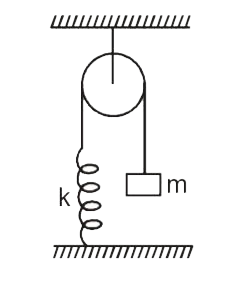Figure shows a composite pulley of that consist of two cylinders of ‘R’ '2 R' stacked coaxially. Moment of inertia of composite pulley is MR24.A light string is wound over pulley and another pulley 'A' of mass 'M' is hanged through the string as shown in figure
The composite pulley is rotated with angular velocity ω in the direction shown. The pulley ‘A’ will -

Go up with velocity R2ω
Go up with velocity Rω
Go down with velocity Rω
Will not move
The correct Answer is:A
Step by step video & image solution for Figure shows a composite pulley of that consist of two cylinders of ‘R’ '2 R' stacked coaxially. Moment of inertia of composite pulley is (MR^(2))/(4) .A light string is wound over pulley and another pulley 'A' of mass 'M' is hanged through the string as shown in figure The composite pulley is rotated with angular velocity omega in the direction shown. The pulley ‘A’ will - by Physics experts to help you in doubts & scoring excellent marks in Class 12 exams.
Updated on:21/07/2023Topper's Solved these Questions
- 10 ROTATIONALBOOK - MOTIONCHAPTER - 10 ROTATIONALEXERCISE - Exercise - 2 (Level - II)
25 Videos
- 10 ROTATIONALBOOK - MOTIONCHAPTER - 10 ROTATIONALEXERCISE - Exercise - 3 (Level - I)
27 Videos
- 10 ROTATIONALBOOK - MOTIONCHAPTER - 10 ROTATIONALEXERCISE - Exercise - 1
77 Videos
- ALTERNATING CURRENTBOOK - MOTIONCHAPTER - ALTERNATING CURRENTEXERCISE - EXERCISE - 4 (LEVEL - II)
14 Videos
Similar Questions
Figure shows a composite pulley of that consist of two cylinders of ‘R’ '2 R' stacked coaxially. Moment of inertia of composite pulley is MR24.A light string is wound over pulley and another pulley 'A' of mass 'M' is hanged through the string as shown in figure
If there were no friction between string and pulley ‘A’, then the acceleration of pulley ‘A’ will be -

View SolutionA mass string going over a clamped pulley of mass m supports a block of mass M as shown in the figure. The force on the pulley by the clamp is given

View Solution
Knowledge Check
A string of negligible mass going over a clamped pulley of mass m supports a block of mass M as shown in the figure. The force on the pulley by the clamp is given by
 A√2MgB√2mgC√(M+m)2+m2gD√(M+m)2+M2g
A√2MgB√2mgC√(M+m)2+m2gD√(M+m)2+M2gA string of negligible mass going over a clamped pulley of mass m supports a block of mass M as shown in the figure. The force on the pulley by the clamp is given by
 A√2MgB√2mgC√(M+m)2+m2gD√(M+m)2+M2g
A√2MgB√2mgC√(M+m)2+m2gD√(M+m)2+M2gIf the string & all the pulleys are ideal, acceleration of mass m is :-
 Ag2B0CgDdependent on m
Ag2B0CgDdependent on m
find the acceleration of the block of mass M in the situation shown in figure. All the surfaces are frictionless and the pulleys and the string are light.

View SolutionThe string, the spring and the pulley shown in figure are light. Find the time period of the mass m.

View SolutionCalculate the accelerations of the pulleys B and C and the tension in the string passing over the pulley A of the figure Figure 5.22.
View SolutionThe string, spring and the pulley shown in figure are light. Find the time period of the mass m.

View SolutionThe tension in the string in the pulley system shown in
 .
.
View Solution